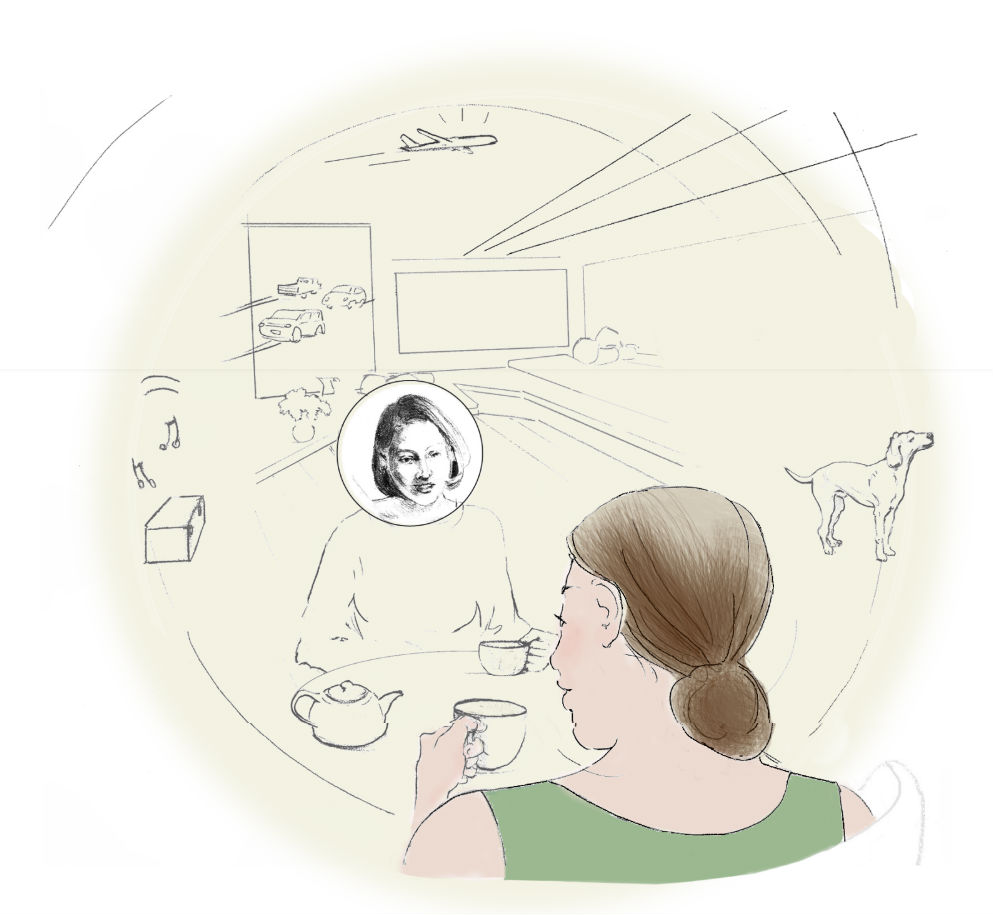Culadasa: Disentangle From Your Thoughts and Emotions
By Culadasa
One thing that all successful meditation practices have in common, whether it’s acknowledged or not, is stable attention and mindfulness. You could even say these are the two functional objectives of the meditation process. And although you may have never noticed before, conscious experience takes two distinct forms: attention and peripheral awareness.
Attention and peripheral awareness are associated with different brain networks that process information in fundamentally different ways. They are two quite different ways of “knowing” the world. Paying attention involves a bilateral dorsal network of structures that selectively engages specific objects, is top-down, voluntary and intentional, focal, highly verbal, abstract, mostly conceptual, and evaluative. Peripheral awareness involves a right-lateralized ventral network that provides an open awareness that automatically orients to new stimuli, can disengage and redirect attention, is bottom-up, stimulus-driven, panoramic, minimally verbal, concrete, mainly sensory, and non-judgmental.
The main thing these two systems have in common is that both contribute to conscious experience. To be successful in your practice, you must work with both attention and peripheral awareness to stabilize attention and cultivate mindfulness.
But what is “mindfulness”? I’m sure you’ve noticed how hard it is to define, and how many ways different meditation teachers define mindfulness. It’s a translation of the Pali word sati that suggests being attentive, or remembering to pay attention. But this doesn’t really capture the meaning of sati, because even without sati we’re always paying attention to something.
Having sati actually means you’re more fully conscious and alert than normal, and are paying attention to the right things in a more skillful way. This is because your peripheral awareness is much stronger, and attention is being used with unprecedented precision and objectivity. More specifically, mindfulness means the optimal interaction between attention and peripheral awareness.
To really grasp mindfulness, we first have to know what attention and peripheral awareness normally do. They have different functions and provide two distinct kinds of information, but they also work together. To respond intelligently to our environment, we need both. Let’s see how ordinary attention and awareness can become that optimal interaction we call mindfulness.
Peripheral awareness includes everything. It’s open and inclusive, as well as holistic and only minimally conceptual. It’s concerned with the gestalt, the relationships of objects to each other, and to the whole. Attention, on the other hand, picks out one object from the field of conscious awareness to analyze and interpret. Once an object of attention has been identified and analyzed, it can be further examined, reflected on, judged, and responded to. Attention takes our experience of the world in all its raw fullness and reduces it to a representation of reality we can more easily understand and manipulate.
The faculty of attention helps us discern between conflicting pieces of information (e.g., is that a snake in the road, or just a piece of rope?). Peripheral awareness allows us to respond more effectively by giving us information about the background and context of our experience – where we are, what’s happening around us, what we’re doing and why (e.g., we don’t think a rope might be a snake, because we’re in Alaska, and it’s winter). Thus Attention and peripheral awareness work together, attention analyzing our experience, and peripheral awareness providing the context.
- When one or the other doesn’t do its job, or when there isn’t enough interaction between the two, then we respond to situations less effectively. We may overreact, make poor decisions, or misinterpret what’s going on.
Anything new – a sensation, thought, or feeling – appears first in peripheral awareness, which then determines whether it’s important enough to become an object of attention. Less information is filtered out while objects that deserve closer scrutiny by attention are spotlighted. As attention hones in, peripheral awareness is on the lookout for anything new or unusual. When awareness takes in something that might be of interest, it redirects attention toward the new object.
Say you’re engrossed in a conversation while walking when you notice a shape moving towards you. Peripheral awareness alerts attention, which processes the information, “We’re in the bike lane and a biker is heading straight for us!” You grab your friend and step out of the way.
- Peripheral awareness helps us stay alert to our surroundings and to use attention as effectively as possible. When peripheral awareness doesn’t do its job, attention moves blindly, without guidance, and can be taken off guard.
Not every experience needs to be analyzed. Peripheral awareness takes care of many things without invoking attention, such as brushing a fly away from your face while talking. Attention can certainly be involved, but because there are so many such basic tasks, using attention for all of them would be impossible. Also, some situations happen too fast for attention to deal with. Because peripheral awareness doesn’t process information as thoroughly as attention, it responds much more quickly. For instance, attention can’t provide the quick, reflexive response of a mother who stops her child from running into a busy street.
- If peripheral awareness doesn’t do its job, attention is too easily overwhelmed and too slow to perform these functions. Then we fail to react to significant events at all, or we react to them in a completely unconscious and automatic way – blindly, mindlessly, and with none of the benefits of conscious processing.
Another way attention and awareness work together is helping us see things objectively. On its own, attention involves a strong concern for “self.” This makes sense, considering part of attention’s job is to evaluate the importance of things in terms of our well-being. But it also means that objects of attention can be easily distorted by desire, fear, aversion, and other emotions. Attention also leads us to identify with external objects (this is “my” car), or mental states (“I am” angry, happy, etc.).
Peripheral awareness is less “personal” and takes things more objectively “as they are.” Rather than being identified with, external objects, feeling states, and mental activities appear in peripheral awareness as part of a bigger picture. We may be peripherally aware that annoyance is arising, but this is very different from having the thought, “I am annoyed.” Strong peripheral awareness helps tone down the self-centered tendencies of attention, making perception more objective.
- When peripheral awareness fades, our perceptions become self-centered and distorted.
There are many ways we can lose mindfulness, but they all come down to “awareness deficit disorder”. It takes considerable conscious power to attend to many different objects, so we lose awareness. When we lack mindfulness we become so entangled in our own thoughts and emotions that we forget the bigger picture. Our perspective narrows, and we lose our way. We do and say regretful things that cause needless suffering to ourselves and others.
In meditation, we can become skilled at using attention and awareness together. Mindfulness allows us to recognize our options, choose our responses wisely, and take control over the direction of our lives. It also gives us the power to change our past conditioning and become the person we want to be. Most importantly, mindfulness leads to Insight, and Awakening.
Shambhala Mountain Center hosts The Science of Meditation: Buddhist Wisdom Meets Modern Brain Science with Culadasa, July 5–9, 2017 — click here to learn more
About the Author



